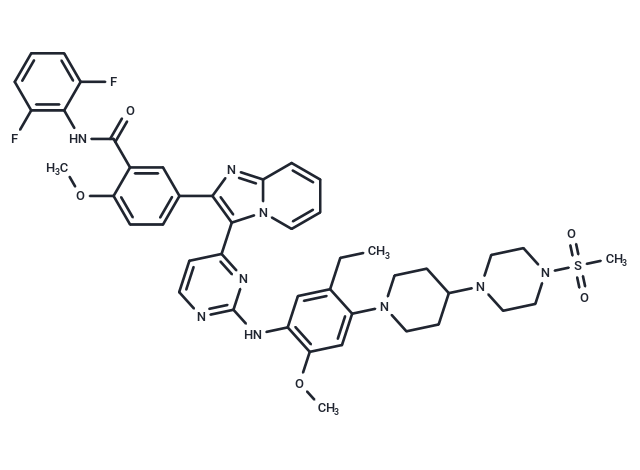Shopping Cart
Remove All Your shopping cart is currently empty
Your shopping cart is currently empty
GSK1904529A (GSK 4529) is a specific inhibitor of IGF-1R (IC50=27 nM) and IR(IC50=25 nM) .

| Pack Size | Price | USA Warehouse | Global Warehouse | Quantity |
|---|---|---|---|---|
| 1 mg | $34 | In Stock | In Stock | |
| 5 mg | $77 | In Stock | In Stock | |
| 10 mg | $119 | In Stock | In Stock | |
| 25 mg | $198 | In Stock | In Stock | |
| 50 mg | $313 | In Stock | In Stock | |
| 1 mL x 10 mM (in DMSO) | $113 | In Stock | In Stock |
| Description | GSK1904529A (GSK 4529) is a specific inhibitor of IGF-1R (IC50=27 nM) and IR(IC50=25 nM) . |
| Targets&IC50 | Insulin receptor:25 nM, IGF-1R:27 nM |
| In vitro | GSK1904529A is a reversible, ATP-competitive inhibitor and has enzyme-inhibitor binding values against IGF-1R and IR with Ki of 1.6 nM and 1.3 nM, respectively. GSK1904529A potently inhibits the ligand-induced phosphorylation of IGF-1R and IR at concentrations above 0.01 μM, followed by blocking downstream signaling (AKT, IRS-1, and ERK). GSK1904529A potently inhibits NIH-3T3/LISN, TC-71, SK-N-MC, SK-ES RD-ES cells with IC50 of 60 nM, 35 nM, 43 nM, 61 nM and 62 nM, respectively. GSK1904529A also inhibits other multiple myeloma and Ewing's sarcoma cell lines including NCI-H929, MOLP-8, LP-1 and KMS-12-BM etc. GSK1904529A induces cell cycle arrest at the G1 phase in cell lines COLO 205, MCF-7, and NCI-H929, which are sensitive to GK1904529A. [1] |
| In vivo | GSK1904529A indicates 98% tumor growth inhibition in NIH-3T3/LISN tumor-bearing mice at a dose of 30 mg/kg (orally, twice-daily) and 75% in COLO 205 xenografts mice (once daily). Among HT29 and BxPC3 xenografts, GSK1904529A produces moderate tumor growth inhibition with no side effects at a dose of 30 mg/kg. Meanwhile, GSK1904529A shows minimal effects on blood glucose levels. GSK1904529A (~3.5 μM in blood) completely inhibits IGF-1R phosphorylation. GSK1904529A has been implicated in treatment of various IGF-1R-dependent tumors including prostate, colon, breast, pancreatic, ovarian, and sarcomas. [1] |
| Kinase Assay | Kinase assays: GSK1904529A is dissolved in DMSO as stock solution at 10 mM. Baculovirus-expressed glutathione S-transferase-tagged proteins encoding the intracellular domain of IGF-1R (amino acids 957-1367) and IR (amino acids 979-1382) are used for determination of IC50. Kinases are activated by preincubating the enzyme (2.7 μM final concentration) in 50 mM HEPES (pH 7.5), 10 mM MgCl2, 0.1 mg/mL bovine serum albumin, and 2 mM ATP. GSK1904529A is diluted in DMSO and dispensed into the assay plates (100 nL/well). Kinase reactions contained (in 10 μL) 50 mM HEPES (pH 7.5), 3 mM DTT, 0.1 mg/mL bovine serum albumin, 1 mM CHAPS, 10 mM MgCl2, 10 μM ATP, 500 nM substrate peptide (biotin-aminohexylAEEEEYMMMMAKKKK-NH2; QPC), and 0.5 nM activated enzyme. Reactions are stopped after 1 hour at room temperature with 33 μM EDTA. Peptide phosphorylation is measured by time-resolved fluorescence resonance energy transfer with 7 nM streptavidin Surelight allophycocyanin and 1 nM europium-conjugated phosphotyrosine antibodies. Plates are read in a multilabel reader. |
| Cell Research | Cells are seeded in 96-well plates and incubated overnight at 37 °C, and treated with various concentrations of GSK1904529A for 72 hours. For the NIH-3T3/LISN, cells are seeded on collagen-coated 96-well tissue culture plates and allowed to adhere for 24 hours. The tissue culture medium is replaced with serum-free medium and the cells are treated with DMSO or GSK1904529A for 2 hours. IGF-I (30 ng/mL) is added and the cells are incubated at 37 °C for 72 hours. Cell proliferation is quantified using the CellTiter-Glo Luminescent Cell Viability Assay. IC50 values are determined. |
| Synonyms | GSK 4529 |
| Molecular Weight | 851.96 |
| Formula | C44H47F2N9O5S |
| Cas No. | 1089283-49-7 |
| Smiles | CCc1cc(Nc2nccc(n2)-c2c(nc3ccccn23)-c2ccc(OC)c(c2)C(=O)Nc2c(F)cccc2F)c(OC)cc1N1CCC(CC1)N1CCN(CC1)S(C)(=O)=O |
| Relative Density. | 1.39 g/cm3 |
| Storage | Powder: -20°C for 3 years | In solvent: -80°C for 1 year | Shipping with blue ice/Shipping at ambient temperature. | ||||||||||||||||||||
| Solubility Information | H2O: < 1 mg/mL (insoluble or slightly soluble) Ethanol: < 1 mg/mL (insoluble or slightly soluble) DMSO: 16.11 mg/mL (18.91 mM), Sonication is recommended. | ||||||||||||||||||||
| In Vivo Formulation | 10% DMSO+40% PEG300+5% Tween 80+45% Saline: 4 mg/mL (4.7 mM), Sonication is recommended. Please add the solvents sequentially, clarifying the solution as much as possible before adding the next one. Dissolve by heating and/or sonication if necessary. Working solution is recommended to be prepared and used immediately. The formulation provided above is for reference purposes only. In vivo formulations may vary and should be modified based on specific experimental conditions. | ||||||||||||||||||||
Solution Preparation Table | |||||||||||||||||||||
DMSO
| |||||||||||||||||||||
| Size | Quantity | Unit Price | Amount | Operation |
|---|

Copyright © 2015-2025 TargetMol Chemicals Inc. All Rights Reserved.